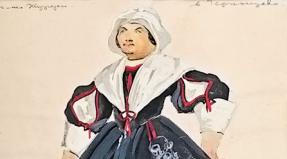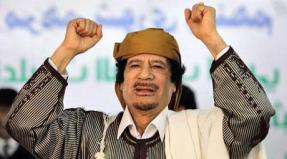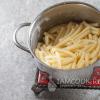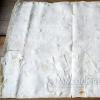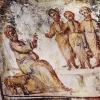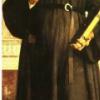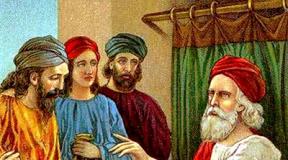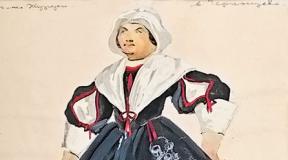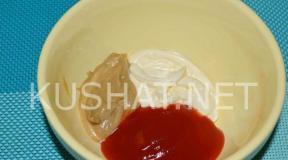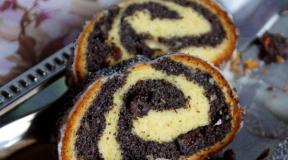The Old Testament Trinity. Icon of the Trinity of the Old Testament (Rublev), also “Hospitality of Abraham Ethiopia: three elders
“Here is the limit of what cherubs cover with their wings.” So St. Athanasius the Great speaks of the incomprehensible mystery of the Trinity Divinity. However, our Lord lifts the curtain for the sake of salvation. According to the teachings of St. fathers, God the Trinity, in addition to his relationship to the world, has an infinite fullness of inner life, He is boundless and all-perfect Love.
The Holy Trinity. Painting of the Chapel of Our Lady in Mon. ap. John the Theologian. Patmos, Greece. End of the 12th century
The concept of unity and the highest properties does not exhaust the entirety of the Christian teaching about God. Faith initiates us into the deepest mystery, presenting the One Divine Being as trinitarian in Persons: God the Son and the Holy Spirit are eternal and omnipotent, like God the Father. The Truth of the Trinity of God is the distinctive property of Christianity - there is no direct revelation of it in the Old Testament teaching, where we find figurative, hidden indications that can be fully interpreted only in the light of the New Testament. Such, for example, are the sayings that testify to the plurality of the Persons of the Divine: “Let us make man in our image and likeness” (Gen. 16:26); “Behold, Adam has become like one of Us” (Genesis 3:22); “Let us go down and confuse their language there” (Gen. 11:7). Another biblical example is the appearance of God to Abraham in the form of three strangers, when three act as one. It is no coincidence that the forefather Abraham, talking with them, uses the singular number.
The Trinity doctrine is one of the deepest and most incomprehensible mysteries of God's revelation. The human mind is unable to imagine how three independent Persons of God, of absolutely equal dignity, can constitute a single and inseparable Being. “Here is the limit of what the cherubim cover with their wings,” notes St. Athanasius the Great. “For all its incomprehensibility, the doctrine of the Holy Trinity has important moral significance for us, and, obviously, that is why this mystery is revealed to people.” According to the teachings of St. Fathers, the Holy Trinity, in addition to its relationship to the world, has an infinite fullness of inner, mysterious life. The ancient teacher of the Church Peter Chrysologus says that “God is one, but not alone.” In Him there is a difference between Persons who are in continuous communication with each other: “God the Father is not born and does not come from another Person, the Son of God is eternally born from the Father, the Holy Spirit is eternally emanating from the Father.”

The appearance of three strangers to Abraham. Fresco in the catacombs on Via Latina, Rome. IV century
Along with the concept of the Trinity, a joyful and significant idea comes to the world: God is infinite and all-perfect Love. The beliefs of Judaism and Islam do not reveal the true meaning of love as the dominant property of God. Love in its essence is unthinkable outside of union and communication. But if God is one-person, in relation to whom is His love revealed before the creation of the world? The highest Love requires the same highest object for full manifestation.
Only the mystery of the Triune God reveals that the love of God has never remained inactive, without manifestation. The persons of the Holy Trinity have been in continuous communion of love from eternity: the Father loves the Son (John 5:20; 3:35) and calls Him Beloved (Matthew 3:17; 17:5, etc.), and the Son repeatedly testifies to love to the Father (see, for example, John 14: 3). According to St. Augustine, the mystery of the Christian Trinity is the mystery of Divine Love: “You see the Trinity if you see love.”

The Appearance of Strangers to Abraham and the Hospitality of Abraham. Mosaic of the central nave. Church of Santa Maria Maggiore. Rome, V century
This is the basis of all Christian moral teaching, the essence of which is the commandment of love. The Lord says to His disciples: “A new commandment I give to you, that you love one another” and “by this they will know that you are My disciples, that you have love for one another” (John 13:34-35). According to the holy fathers, the nature of people is one, like the nature of the Trinity, but only our unity is weakened by sin and restored by the atonement of Jesus Christ. Shortly before suffering and death on the cross, the Savior, surrounded by His disciples, appealed to the Father: “I pray not only for them, but also for those who believe in Me through their word: that they may all be one, that the world may believe that You sent Me. And the glory that You gave Me, I have given them: that they may be one, even as We are one. I in them, and You in Me, may be made perfect in one, and that the world may know that You sent Me and loved them as You loved Me” (John 17:21-23).
Trinity Old Testament
Christian art faced a difficult task - to convey the Revelation of the Trinity visually. The visual symbolism of the early era offered an option that became entrenched in iconography. In the Roman catacombs of the 4th century. on Via Latina there is a fresco where three strangers appear to Abraham. It is based on the biblical story about the meeting of the forefather Abraham and three men near the oak grove of Mamvre (Gen. 18: 1-16). As is known, this episode was interpreted by theologians of the early Church in different ways. Some saw in him the appearance of God in Three Persons, others - the appearance of God accompanied by two angels.

Hospitality of Abraham. Mosaic of the presbytery of the Church of San Vitale. Ravenna. 546-547
In the mosaic of naosa c. Santa Maria Maggiore (Rome, 5th century) the plots of “The Appearance of Three Strangers to Abraham” and “The Hospitality of Abraham,” where he treats the guests sitting at the table, are combined in one composition. Abraham offers the calf, Sarah prepares the bread. On the left is Abraham's house and a small tree. In the mosaic of the presbytery c. San Vitale in Ravenna (546-547) the composition “The Hospitality of Abraham” includes a scene of the sacrifice of Isaac. The theme of sacrifice (Eucharistic) is heard here twice. On the left, a servant hands the three strangers a prepared calf on a platter; on the right, Abraham raises a sword over his son. A lamb is already standing nearby, and God (the blessing hand from heaven) stops Abraham. Behind Isaac there is a mountain depicted - a mountain in the land of Moriah (Gen. 22: 1-19). In the center, three guests are sitting at a table under a tall, spreading oak tree; Sarah is standing in the doorway of the house on the left. Already in these early monuments an iconographic scheme was outlined, which “is of a completely theologically meaningful nature.”
In subsequent centuries, the composition “The Hospitality of Abraham” will appear in many versions, but most often, in addition to the three strangers sitting at the table, it includes the figures of the forefathers Abraham and Sarah, sometimes their servant, slaying the calf and preparing the meal. Abraham's house, a tree (the oak of Mamre) and hills are often depicted.

The prepared throne (Etimasiah). Mosaic of the Church of the Assumption in Nicaea. End of the 7th century
During iconoclasm, anthropomorphic images of the Holy Trinity were replaced by symbolic ones. One of the most famous, even from the pre-iconoclastic period, is a mosaic from the end of the 7th century. “The prepared throne” (Greek Έτοιμασία - “readiness”) from the Church of the Assumption in Nicaea, which, unfortunately, was preserved only in photographs of the late 19th century by the Russian Archaeological Institute in Constantinople. The Throne here means the Kingdom of God the Father. The book on the Throne is a symbol of the Logos, the Second Person of the Holy Trinity, and the dove that descends on it is a symbol of the Holy Spirit.
In the post-iconoclastic era, the "Hospitality of Abraham" iconography once again proliferates in Byzantine art. At this time, various compositional schemes are developed. Forefathers Abraham and Sarah can be located in the foreground, to the right or left of the Angels, between them. Sometimes they look out from the windows of the chambers or are not depicted at all (fresco in the Church of St. George. Djurdjevi Stupovi Monastery near Stari Ras. Serbia, 12th century). In monumental painting, two independent compositions are often dedicated to the subject of the Trinity: “The Appearance of Three Angels to Abraham” and “The Hospitality of Abraham.” As a rule, in the painting of the temple they follow each other (frescoes of the Cathedral of St. Sophia in Kyiv, 11th century; Church of St. Sophia in Ohrid, Macedonia, 11th century; mosaics of the Cathedral of Monreale in Palermo, Sicily, 12th century, etc. .).
The dwelling of Abraham, the Oak of Mamre, the hills, and especially the servant slaying the calf are not always depicted. A common feature is the selection of a cup at the table (Throne) with a prepared (sacrificed) calf. Isocephaly, a frontal composition with an equal-sized image of Angels, characteristic of early monuments, gives way to a triangular scheme in the Komninian and Paleologian periods. According to I. Yazykova, “at an early stage, it was important to affirm the unity of the hypostases in the Holy Trinity; at a later time, the hierarchical idea was emphasized.”

Meeting of Abraham and three angels. Hospitality of Abraham. Mosaic of the Monreale Cathedral. Palermo, Italy. XII century
The iconography of “Abrahamic hospitality”, or the “Trinity of the Old Testament”, came to Rus' in the 11th century. The fresco in the Cathedral of St. Sophia of Kyiv dates back to this time. The image on the southern and western gates of the Cathedral of the Nativity of the Virgin Mary in Suzdal dates back to the 13th century, and the famous fresco of Theophanes the Greek in the Novgorod Church of the Transfiguration on Ilyin Street dates back to 1378. Icons from the 14th and early 15th centuries are known. (four-part Novgorod icon of the 14th century; the so-called “Zyryan Trinity” from Vologda, late 14th century; Pskov icon with an isokephal composition of the late 14th - early 15th centuries)
Trinity New Testament

Fatherland. Novgorod icon. Con. XIV century Tretyakov Gallery.
Later, interpretations appear that can be united under the name “Trinity of the New Testament,” which, according to researchers, go back to the Latin tradition. They represent God the Father in the form of an Elder (Old Denmi), sitting on a throne and holding on his knees (in the bosom) the Child Son, in whose hands is a medallion or sphere with a dove flying out of it - the Holy Spirit. This iconography, called “Fatherland”, known back in Byzantium, we see on the Novgorod icon of the 14th century. The Trinity is preceded by selected saints - the pillars Daniel and Simeon, as well as one of the apostles, who are depicted as young: Thomas or, rather, Philip. In the Gospel of John, the Apostle Philip turns to Christ: “Show us the Father, and it will be enough for us,” to which Christ replies: “He who has seen Me has seen the Father also” (John 14:8-9). It is noteworthy that the halos of both the Father and the Son are cross-shaped, and the upper inscription “Father and Son and Holy Spirit” is accompanied by two smaller inscriptions “IC XC” (Jesus Christ) behind the shoulders of the Old Denmi and in the sphere above the dove. Perhaps in this way the icon painter tried to depict God the Father, interpreting Him as the Ancient Jesus Christ, existing eternally in the bosom of the Father.

Co-throne. Icon of the beginning XVIII century Moscow.
The image of the New Testament Trinity contradicts the teaching of the Church about the triune, eternal and incomprehensible Deity. God the Father “has never been seen by anyone” (John 1:18), and His depiction as an old man does not correspond to the truth. Just as the image of God the Son, co-originating with the other two Hypostases of the Holy Trinity, is impossible in the form of a youth on the knees of God the Father. The Holy Spirit appeared to people in the form of a dove (Baptism of the Lord) and in the form of tongues of fire (Pentecost), but no one knows what He looks like in eternity. Although the images of the Fatherland (New Testament Trinity) from the 17th century. meet often, the Church treats them critically. The definition of the Great Moscow Council of 1667 prohibits icons of the Lord of Hosts, or the “Old Day,” as well as the “Fatherland.”
There are also other iconographic versions of the New Testament Trinity. Thus, the “Co-throne” has a frontal composition, depicting God the Father (Old Day) and God the Son in the form of a heavenly king, sitting on a throne. The Holy Spirit in the form of a dove hovers over Them or between Them. This image illustrates the peculiarities in understanding the relationship of hypostases in the Catholic dogma of the Trinity, in which the Holy Spirit is interpreted as the love between God the Father and God the Son. It is important to note that in the “Co-throne”, and even more so in the “Fatherland”, the consubstantiality and equality of all three hypostases is practically not read.
Holy Trinity by Andrei Rublev

Theophanes the Greek. Trinity. Painting c. Transfiguration of the Savior on Ilyin Street. Novgorod. 1378
There is only one icon, which in Rus' defines the very feast of the Holy Trinity - on it God the Trinity appears in the form of three Angels. There are several options for reading the “Old Testament Trinity”. So, L.L. Lebedev offers the following: 1) Three Persons of the Holy Trinity - God the Father, God the Son, God the Holy Spirit (“Trinity” by Andrei Rublev); 2) Jesus Christ “according to divinity”, accompanied by two Angels; (fresco by Theophan the Greek; icon “Abraham’s Hospitality”, Novgorod, 16th century); 3) three Angels as the “image and likeness” of the Holy Trinity (mosaics of the Church of Monreale, Palatine Chapel in Palermo; Pskov icon of the late 14th - early 15th centuries); 4) three people representing the image of the Holy Trinity (mosaics of the Church of Santa Maria Maggiore in Rome and the Church of San Vitale in Ravenna).
Over the centuries, the Church has become stronger in the opinion that the dogma of the Holy Trinity is most fully revealed precisely in the first interpretation, where equal dignity symbolizes the trinity and equivalence of all Three Persons. We find an expression of this in the icon painted by the Monk Andrei Rublev (July 4/17) for the Trinity Cathedral of the Trinity-Sergius Monastery. This masterpiece of ancient Russian painting was approved by the Church as a model for painting icons of the Holy Trinity. Reverend Andrei surprisingly deeply revealed the theological essence of the Trinity teaching. In his icon, the faces of the Holy Trinity follow in the order they are confessed in the Creed. The First Angel is the first Person of the Trinity, God the Father; the second (middle) Angel is God the Son; the third Angel is God the Holy Spirit. “All three Angels bless the cup in which the calf, slain and prepared for food, was brought. The slaughter of the calf marks the death of the Savior on the cross, and the preparation of the calf for food is a prototype of the Eucharist.”

Andrey Rublev. Trinity. Icon from the local row of the iconostasis of the Trinity Cathedral of the Trinity-Sergius Lavra. 1st quarter XV century Tretyakov Gallery
The biblical characters Abraham, Sarah and the servant appear “behind the scenes”, although laconic images of the chambers of Abraham, the Mamre oak and the hills are present. Rublev depicts only the Eternal Council, the essence of which is the voluntary consent of the Second Person of the Most Holy Trinity to offer Himself as an atoning sacrifice for the salvation of man and the whole world. The table around which the Angels sit is not a banquet table, it is an altar for making sacrifices. The cup also has Eucharistic significance; it is present at the sacramental meal - the communion of believers with the Body and Blood of the Lord. In addition, the internal contours of the figures of the outermost Angels form the outline of a bowl, in which the figure of the middle Angel seems to be involuntarily enclosed. I remember the prayer of the Son of God in the Garden of Gethsemane: “My Father! If possible, let this cup pass from Me” (Matthew 26:39).
All three Angels have staffs in their hands, which symbolize Their Divine power. The first Angel, depicted on the left side of the icon, is dressed in a blue tunic - an image of His heavenly, Divine nature, and a light purple himation, testifying to incomprehensibility and royal dignity. In the background, above His head, stands the house, Abraham's dwelling, and the altar in front of the house. This image of a dwelling has a symbolic meaning and is an image of God’s economy. The placement of the building above the head of the first Angel indicates Him as the head (Father) of this economy. The same paternal principle is reflected in His entire appearance: the head is almost not tilted, and the gaze is turned to the other two Angels. And the features, and the facial expression, and the position of the hands, and the way the first Angel sits straight - everything speaks of His paternal dignity. The other two Angels bow their heads and look at the first one in deep attention, as if conducting a conversation with him about the salvation of mankind.
The second Angel is placed in the center. His middle dignity is determined by the position that is inherent in the Second Person in the Trinity Itself, as well as in the work of God’s economy and providence for the world. The robe corresponds to the one in which the Savior is usually depicted: the tunic has a dark purple color, symbolizing the incarnation, and the upper blue himation signifies the Divine dignity and heavenly nature of His nature. The oak overshadowing the Angel is a reminder of the tree of life that was in the middle of paradise, and also marks the tree of the cross.
The angel sitting on the right is the third Person of the Holy Trinity - the Holy Spirit. His lower robe, transparent blue, and his upper robe, light smoky green, depict heaven and earth, signifying the life-giving power of the Holy Spirit, which gives life to all things. “By the Holy Spirit every soul is alive and exalted in purity” (antiphon at Matins) – sings the Holy Church. This exaltation is expressed in purity in the icon by the mountain that overshadows the third Angel. The arrangement of the three Persons on the icon corresponds to the order that permeates every liturgical exclamation, every appeal and confession of the Holy Trinity. The outlines of three seated Angels, carrying staffs and blessing the meal, are also subordinated to this.

Trinity Zyryanskaya. Icon con. XIV century Vologda historical-architect. and artist museum-reserve.
We find a similar understanding in the works of the largest researchers of ancient Russian painting V.N. Lazarev and M.V. Alpatova. There are other interpretations. D.V. Ainalov believed that the middle Angel depicts God the Father, the left one - Christ, the right one - the Holy Spirit, as in the so-called “Zyryansk Trinity” of the Vologda Cathedral, built in 1395 by a disciple of St. Sergius of Radonezh by Saint Stephen of Perm, where the middle Angel is designated as God the Father. According to N. Malitsky, on the contrary, the middle Angel in this icon depicts Christ, the left - God the Father. It is not without reason that in the images of the Trinity in a number of ancient Russian icons, a cross-shaped nimbus surrounds the head of only the middle Angel, and in Rublev’s icon, only he has a clave on his sleeve. ON THE. Demina and I.K. Yazykov identify the central figure with the image of God the Father. B. Rauschenbach insists on trinitarian unity as the dogmatic content of the icon. Attempts to assign a certain hypostasis to each Angel seem insignificant to him, which, in particular, is confirmed by the name “Holy Trinity” of the icon as a whole, and not each hypostasis by name.
According to the holy fathers, an icon can rightfully only be an image that has a face - a human face transformed by divine light. The Savior Himself, having imprinted His Face on the ubrus, as on an icon of icons, gave us the source of every holy image. Even the symbols of the evangelists are not an independent icon. Thus, the eagle holding the Gospel is only a sign of the Evangelist John. The same symbol, but not a full-powered icon, is the image of the Holy Spirit in the form of a dove, as on New Testament icons. The most important feature of Rublev’s image is that the third Person of the Holy Trinity - the Holy Spirit - is depicted equally with the first and second Persons and has in His image the fullness of the angelic and human image.
In addition to the historical, symbolic and allegorical interpretation of the Trinity, Rublev M.V. Alpatov gives didactic information. He believes that “Rublev could not help but be captivated by the task of filling the traditional image with the ideas that lived his time... Ancient sources say that Rublev’s icon was painted “in praise of Father Sergius,” and this indication helps to understand the range of ideas that inspired Rublev. We know that Sergius, blessing Dmitry Donskoy for his feat, set as an example the very sacrifice that Rublev immortalized in the Trinity. At the same time, he built the Trinity Cathedral for the people he united “for a common life,” “so that by looking at the Holy Trinity the fear of the hated discord of this world could be overcome.” This helps to understand the ethical meaning of Rublev’s Trinity.” In his work, he poses a vital question of those years, “when on the battlefield only the united efforts of previously scattered principalities could break the resistance of the age-old enemy.”

Andrey Rublev. Trinity. Fragment.
The priest and theologian Pavel Florensky calls the icon of St. Andrew a revelation. In it, “among the turbulent circumstances of the time, among discord, internecine strife, general savagery and Tatar raids, amid this deep peacelessness that corrupted Rus', the endless, imperturbable, indestructible ... “supreme peace” of the heavenly world was revealed to the spiritual gaze. The enmity and hatred reigning in the earthly world was opposed by mutual love, flowing in eternal harmony, in eternal silent conversation, in the eternal unity of the heavenly spheres. This inexplicable world... this azure that is unequal to anything in the world - more heavenly than the earthly sky itself... this premium silence of wordlessness, this endless submission to each other - we consider the creative content of the Trinity... But in order to see this world, in order to absorb this cool, life-giving breath of the spirit into his soul and into his brush, the artist needed to have a heavenly prototype in front of him, and an earthly reflection around him, to be in a spiritual environment, in a peaceful environment. Andrei Rublev, like an artist, fed on what was given to him. And therefore, not the Venerable Andrei Rublev, the spiritual grandson of the Venerable Sergius, but the founder of the Russian land himself, Sergius of Radonezh, should be revered as the true creator of the greatest of the works not only of Russian, but, of course, of the world... Of all the philosophical proofs of the existence of God, concludes O. Pavel Florensky, sounds most convincingly: there is Rublev’s Trinity, therefore there is God.”
_____________________
1. Alexander (Mileant), bishop. One God worshiped in the Trinity. [Electronic resource]. Address: https://azbyka.ru/otechnik/Aleksandr_Mileant/edinyj-bog-v-troitse-poklonjaemyj/
2. Athanasius the Great, St. Epistle to Serapion 1st // Works like the saints of our father Athanasius the Great, Archbishop of Alexandria. Part 3. Ed. 2nd, rev. and additional – M.: Publication of the Spaso-Preobrazhensky Valaam Monastery, 1994. – P. 3-49.
3. Alexander (Mileant), bishop. Decree. op.
4. Peter Chrysologus (c. 380-450), bishop. Ravenna, St. The words belong to him: “God is one, but Trinity; alone, but not alone" (Deus unus est, sed trinitate; solus est, sed non solitaries). See: Sermon LX, p. 366 // Petrus Chrysologus. Sermones. [Electronic resource]. Address: http://www.documentacatholicaomnia.eu/02m/0380-0450,_Petrus_Chrysologus,_Sermones,_MLT.pdf
5. Alexander (Mileant), bishop. Decree. op.
6. Augustine the Blessed, St. About the Trinity. – M.: Ripol classic, 2018 – Part I. Book. 8th, ch. 12.
7. Naos (from the Greek Ναός - temple, sanctuary) - the central part of a Christian temple, where worshipers are located during worship.
8. Presbytery (from other Greek Πρεσβυτέριον - a meeting of priests) - in early Christian basilicas and modern Western European churches, the space between the nave (naos) and the altar. Intended for the priesthood.
9. Yazykova, I. Iconography of the Holy Trinity: Is it possible to depict God the Father? // Irina Yazykova. Co-creation of an image. Theology of the icon. / Series “Modern Theology” - M.: BBI Publishing House, 2012. - P. 119.
10. Ibid. P. 120.
11. Ibid. P. 122.
12. Ancient denmi (ancient, ancient of days) - a symbolic image of Jesus Christ, as well as God the Father in the form of a gray-haired old man. Goes back to the prophecy of Daniel: “I saw at last that thrones were set up, and the Ancient of Days sat down; His robe was white as snow, and the hair of His head was like pure wool; His throne is like a flame of fire, His wheels are like blazing fire” (Dan 7:9).
13. Lebedev, L.L. (Lev Regelson). Who is depicted in the Trinity icon by Andrei Rublev? // Science and Religion. – 1988. – No. 12.
14. Gregory (Circle), monk. About the image of the Holy Trinity // Thoughts about the icon. – St. Petersburg: Direct-Media, 2002.
15. Ibid.
16. Lazarev, V.N. Andrei Rublev and his school. – M.: Art, 1966.
17. Alpatov, M. V. Andrey Rublev. – M.: Fine Arts, 1972.
18. Malitsky N.V. On the history of the composition of the Old Testament Trinity. – Prague, 1928. pp. 33-47.
19. Demina, N.A. "Trinity" by Andrei Rublev. – M.: Art, 1963.
20. Rauschenbach, B.V. Coming to the Holy Trinity // Passion. M.: Agraf, 2011.
21. Alpatov, M. V. Decree. Op. – P. 100.
22. Florensky, P., priest. Iconostasis // Collection. op. T.1: Articles on art. – Paris: YMCA-press, 1985.
Please follow the rules of respectful tone. Links to other sources, copy-paste (large copied texts), provocative, offensive and anonymous comments may be deleted.
1 0
In early Christian art, several types of iconography of angels are known, dating back to the ancient images of winged geniuses, erotes, Nike.
One of the earliest depictions of an angel appears in the Annunciation scene in the Catacombs of Priscilla in Rome, ser. III century - a young man in a white tunic and pallium, wingless.
In the 4th century. a similar type of angel depicted without wings is quite stable and is found in catacomb paintings on biblical subjects: “The Appearance of Three Angels to Abraham,” “The Appearance of an Angel to Balaam,” and “The Vision of the Ladder to Jacob” in the catacombs on Via Latina in Rome, ser. IV century; "Tobias and the Angel" in the catacombs of Vigno Massimo, ser. IV century; also in the scene of the heavenly Meal in the tomb of Vincent and Vibia on Via Appia in Rome, beg. IV century, and on the sarcophagus in c. San Sebastiano in Rome, IV century. (on the last one the angel is a medieval man with a beard).
"The Appearance of Three Angels to Abraham", catacombs on Via Latina in Rome, ser. IV century ( *image is clickable)
"The appearance of an angel to Balaam", catacombs on Via Latina in Rome, ser. IV century
"Vision of Jacob's Ladder", catacombs on Via Latina in Rome, ser. IV century
The first images of angels with wings
The winged angel (symbol of the Evangelist Matthew) was first depicted on the mosaic of the apse conch in the Basilica of Santa Pudenziana in Rome, con. IV century
Mosaic of the apse conch in the Basilica of Santa Pudenziana in Rome, con. IV century( *image is clickable)
Mosaic of the apse conch in the Basilica of Santa Pudenziana in Rome, con. IV century Fragment
(*image is clickable)
Both types of angels, winged and unwinged, are represented in the Church of Santa Maria Maggiore in Rome, 432-440. (in the composition on the triumphal arch - winged, in the nave in the "Hospitality of Abraham" scene - wingless) and in the Church of San Vitale in Ravenna, c. 547 (on the triumphal arch the angels carrying the cross in the medallion are winged, in the presbytery in the scene “The Hospitality of Abraham” they are wingless).
From the 5th century angels are depicted, as a rule, winged, with halos, in white tunics with clades and white palliums, wearing roman lungs. sandals.
They are represented on the sides of the Virgin and Child (mosaic of the Church of Sant'Apollinare Nuovo in Ravenna, before 526), supporting a mandorla (Gospel of Rabbi, 586 (Laurent. Plut. 1. Cod. 56)) or a medallion with the image of Jesus Christ (imp. diptych (Barberini), late 5th-early 6th century (Louvre, Paris)), cross (diptych of St. Lupicinus, 6th century (National Library, Paris), lamb (mosaic of the dome of the Church of St. Vitale in Ravenna), medallion with a monogram of the name of Jesus Christ (sarcophagus, ca. 400 (Archaeological Museum. Istanbul)).
Mosaic of the church of Sant'Apollinare Nuovo in Ravenna, before 526 ( *image is clickable)
Gospel of Rabbala, 586 ( *image is clickable)
Mosaic of the dome vault c. San Vitale in Ravenna ( *image is clickable)
Sophia, the Wisdom of God, and Christ, the Angel of the Great Council, are depicted as an angel.
In the late Middle Ages. During this period, the iconography “Cathedral of Angelic Forces” was widespread, representing the unity of angels under the leadership of the archangels Michael and Gabriel to protect the Throne of God.
Cathedral of the Archangels. Late XV - early XVI centuries.
Icon It is worthy to eat. Russian North. Second half of the 16th century. State Tretyakov Gallery
Angels are depicted in Old Testament scenes, in theophanic visions, and are included in the compositions of the proto-Gospel cycle and the twelve feasts. As a rule, images of angels are accompanied by the inscription: “Angel of the Lord” or “Angels of the Lord.”
Angels' Robes
As archangels of the heavenly army, angels can be depicted in military garb - in a tunic and a cloak with a tavlion (mosaic of the triumphal arch of St. Apollinare in Classe in Ravenna, 6th century).
Mosaic of the triumphal arch c. Sant'Apollinare in Classe in Ravenna, 6th century.
From the 7th century known images of angels in lorate robes (in dalmatics and lores), in boots embroidered with gold and stones, with a labarum in their hand (Church of the Dormition of the Virgin Mary in Nicaea, 7th century).
Mosaic in c. Dormition of the Virgin Mary in Nicaea, 7th century ( *image is clickable)
In the scenes of the Eucharist, the Service of the Holy Fathers, the Heavenly Liturgy, and the Great Entrance, the angels are dressed in deacon's robes, holding cups, ripids, censers, candles, and shrouds in their hands.
In the XIII-XIV centuries. The image of angels in military armor (armor) is becoming widespread (the icon “The Appearance of the Archangel Michael to Joshua”, 13th century (GMMC)).
icon “Appearance of the Archangel Michael to Joshua”, 13th century.
At the same time, an image of an angel in monastic robes appears, based on an episode from the life of St. Pachomius the Great.
Afterwards an angel in the form of a monk is included in the compositions “The Last Judgment” (icon “The Last Judgment”, 15th century (Tretyakov Gallery)) and “Creation of Angels” (icon “Trinity in Being”, 16th century (SIHM)).
Icon “The Last Judgment”, 15th century. (TG)
Icon “Trinity in Being”, 16th century.
The symbolic meaning of angels' clothes
The clothes of angels have a symbolic meaning.
According to the Areopagitics, “light and fire-like” clothing means “Godlikeness and the power to illuminate in accordance with their state in heaven” (CH XV 4).
Icon. Guardian Angel with deeds. XIX century
Claves and tavlios emphasize the significance of the rank occupied by angels in the heavenly hierarchy.
archangel Michael
The freely flowing ends of the headbands-toroks (rumors) testify to the purpose of the angels to hear the will of God.
Archangel Michael; Byzantium. . Athos; XIV century; location: Greece. . Athos, Hilandar Monastery ( *image is clickable)
As attributes accompanying angelic images, there are labarums with the words of the Trisagion written on them, and mirrors - transparent balls-spheres, through which angels, not daring to look at God, contemplate His reflection. The name of God (IC XC) is usually written on the mirrors, the Eternal Infant Emmanuel or the Calvary cross is depicted.
Angel with labarum, Byzantine mosaic of the Cathedral of Martorana, 12th century ( *image is clickable)
Archangel Gabriel is depicted with a mirror, because Gabriel is the messenger of God's destinies about the salvation of the human race
The rods mean “royal and sovereign dignity and direct execution of everything” (CH XV 5).
Staves are a sign that angels are messengers of God.
In their hands they can also hold standards, scrolls, crowns, torches, instruments of the passions, a medallion with the image of Christ Emmanuel (in the composition “Cathedral of the Ethereal Heavenly Powers”).
Angel with a scroll. XVIII century
Mosaic. Italy. Florence. Baptistery of San Giovanni. Interior. XIII-XIV centuries
Angel trumpeting, angels carrying the instruments of the Passion (nails, crown of thorns, cross) ( *image is clickable)
Image of a Guardian Angel
In the end XVII century in Russian The image of a guardian angel is becoming widespread in art.
Icon "Holy Guardian Angel", 17th century
Icon "Holy Guardian Angel". Vologda, XVII century (1660s-1670s)
The plot is based on the well-known iconographic type “Hospitality of Abraham”. This plot is already found in the Roman catacombs on Via Latina (between the 2nd and 4th centuries),
mosaics of the Roman temple of Santa Maria Maggiore (1st half of the 5th century)
and mosaics of the Ravenna temple of San Vitale (1st half of the 6th century).
It goes back to the biblical story of the appearance of three men to Abraham, that is, it is an iconographic depiction of a specific biblical event. In the second millennium, the custom arose of inscribing the plot “Hospitality of Abraham” with the words “Holy Trinity”: such an inscription appears on one of the miniatures of the Greek Psalter of the 11th century. In this miniature, the head of the middle Angel is crowned with a cross-shaped halo: it faces the viewer frontally, while the other two Angels are depicted in a three-quarter turn.
The same type of image is found on the doors of the Church of the Nativity of the Virgin Mary in Suzdal (c. 1230) and on the fresco of Theophanes the Greek from the Novgorod Church of the Transfiguration on Ilyin Street. The cross halo indicates that the central Angel is identified with Christ.
In the era preceding Andrei Rublev, icons of the Trinity appear with the middle Angel depicted in three-quarter rotation, and without the upcoming Abraham and Sarah. It was this iconographic type that Andrei Rublev followed when he created his “Trinity”. He took as a basis the type that is almost completely abstracted from the original plot (“The Hospitality of Abraham”) and which is most suitable for emphasizing the equality between the three Persons of the Trinity. Above the head of the middle Angel - at least in the form in which the icon has been preserved to date - there is no cross-shaped halo, which, as it were, deprives it of its central meaning and makes it unnecessary to identify it with Christ. Art historians express different opinions on the question of which Angel represents which Person of the Holy Trinity.
Apparently, however, we should not be talking about depicting the Persons of the Holy Trinity at all: Rublev’s “Trinity” is a symbolic image of the trinity of the Divine, as already pointed out by the Council of the Hundred Heads. After all, the visit to Abraham by three Angels was not a manifestation of the Holy Trinity, but was only “a prophetic vision of this mystery, which over the course of centuries will gradually be revealed to the believing thought of the Church.” In accordance with this, in Rublev’s icon we are presented not with the Father, Son and Holy Spirit, but with three Angels, symbolizing the Eternal Council of the three Persons of the Holy Trinity. The symbolism of the Rublev icon is somewhat akin to the symbolism of early Christian painting, which hid deep dogmatic truths under simple but spiritually significant symbols.
The symbolism of the icon and its spiritual meaning are linked with the ideas on which St. Sergius of Radonezh built the monastic community. He dedicated his monastery to the Holy Trinity, seeing in the love between the Hypostases of the Trinity an absolute spiritual and moral guideline for the monastic community. The Icon of the Trinity was commissioned from Rublev by Sergius's disciple, St. Nikon of Radonezh. The image in praise of Sergius of Radonezh “was supposed to be of a distinctly speculative, philosophical nature, in contrast to the previous images of the Trinity.” At the same time, Rublev’s “Trinity,” like its prototype “Abraham’s Hospitality,” is a Eucharistic image symbolizing a bloodless sacrifice. This meaning of the icon was emphasized by its placement in the bottom row of the iconostasis of the Trinity Cathedral, near the royal doors.




Trinity. Icon of the Novgorod school of the 15th century. Leningrad, Russian Museum. 
Holy Trinity in Genesis. 1580s 
Double-sided icon of the Holy Trinity and the head of John the Baptist 
Trinity of the Old Testament. Century: XVI Storage location: State Tretyakov Gallery, Moscow 
The Holy Trinity. S. Ushakov. 1671 
Trinity of the Old Testament. 17th century 
The Holy Trinity 
The Holy Trinity. Icon 18th century 
Abraham gives his son to the slaughter. Mosaic of Ravenna. Saint Vitale.
The iconography is based on the biblical story of how God appeared to the forefather Abraham in the form of three pilgrims under the shade of the Mamre oak. Abraham loved to entertain strangers. Having bowed to them to the ground, he called them to him to rest and refresh themselves with food. One of the strangers told Abraham that in a year his wife Sarah would give birth to a son. Abraham was 99 years old at the time, and Sarah was 89 years old. Sarah, standing behind them, at the entrance to the tent, did not believe it and laughed to herself. But the stranger, who predicted the birth of a son, exposed her unbelief, saying: “Is there anything difficult for the Lord?” And then righteous Abraham realized that God Himself had visited him under the guise of three strangers.
The Holy Trinity is depicted as three Angels sitting under a tree. On the table in front of them is a treat offered by Abraham, who is standing nearby. Sarah is either right there, together with Abraham, standing before the Holy Trinity, or in the tent. In addition to the figures of Angels, the iconographic scheme also included an image of a servant slaughtering a calf and preparing a meal. There are different options for iconographic schemes - the forefathers (Abraham and Sarah) are located in front, to the side, between the Angels, or looking out from the windows of the chambers in the background. The background is usually filled with symbolic images of the chambers of Abraham, the Oak of Mamre and the hills. The iconography options differ in the details of the feast and the episodes of the slaughter of the calf and the baking of bread.
The subject of the Hospitality of Abraham (the Appearance of the Three Angels to Abraham) appears in catacomb painting, for example in Via Latina (4th century), as well as in early mosaics, for example in the Church of Santa Maria Maggiore in Rome (5th century) and in the Church of San Vitale in Ravenna (VI century). The iconography of Abraham's Hospitality came to Rus' very early: St. Sophia Cathedral in Kyiv (XI century), the southern gate of the Cathedral of the Nativity of the Virgin in Suzdal (XIII century) and the famous fresco of Theophan the Greek in the Church of the Transfiguration on Ilyin Street in Novgorod (XIV century).
Trinity Day is celebrated on Sunday on the 50th day after Easter.
Zhanna Grigorievna Belik,
candidate of art history, senior researcher at the Andrei Rublev Museum, curator of the tempera painting fund.
Olga Evgenievna Savchenko,
Researcher at the Andrei Rublev Museum.
Literature:
1. Uspensky L. A. Theology of the icon of the Orthodox Church. Publishing house of the brotherhood in the name of Saint Prince Alexander Nevsky. 1997.
2. Monk Gregory Krug. Thoughts about the icon. Paris, 1978,
3. Saltykov A. A. Iconography of the “Trinity” by Andrei Rublev // Old Russian art of the XIV-XV centuries. M., 1984, pp. 77-85.
4.Malitsky N.V. On the history of the compositions of the Old Testament Trinity. - "Seminarium Kondakovianum", II. Prague, 1928.
5.Vzdornov G. I. Newly discovered icon of the “Trinity” from the Trinity-Sergius Lavra and “Trinity” by Andrei Rublev // Old Russian Art. M., 1970.
6. Trinity of Andrei Rublev: Anthology. Comp. G. I. Vzdornov. M., 1981.
7. Popov G. V., Ryndina A. V. Painting and applied art of Tver XIV-XVI centuries. M., 1979.
8. // Artistic culture of Moscow and Moscow region XIV - early XX centuries. M., 2002.
At the very top of the iconostasis you can see the majestic gray-bearded old men Adam, Noah, Abraham, Melchizedek - forefathers, righteous people who took part in the history of the salvation of mankind. This Sunday, two weeks before the Nativity of Christ, their memory is celebrated.
Forefathers are not necessarily the ancestors of Jesus Christ according to the flesh. The main thing in their veneration is that they are prototypes of the future deliverance from eternal death. In the Orthodox tradition, the forefathers include: Adam, Abel, Seth, Enosh, Methuselah, Enoch, Noah and his sons, Abraham, Isaac, Jacob and the 12 sons of Jacob, Lot, Melchizedek, Job and many others. In the Hebrew text of the Bible they are called “fathers”; in the Greek translation (Septuagint) they are called “patriarchs” (Greek patriarches - “ancestors”).
Their host also includes women - the foremothers Eve, Sarah, Rebekah, Rachel, Leah, the sister of Moses the prophetess Mariam, the judge of Israel Deborah, the great-grandmother of King David Ruth, Judith, Esther, the mother of the prophet Samuel Anna, and sometimes other women whose names have been preserved in The Old Testament or in Church Tradition. Among the New Testament persons, the host of forefathers also includes the righteous Simeon the God-Receiver and Joseph the Betrothed. The Orthodox tradition also includes the righteous Joachim and Anna among the forefathers, calling them “godfathers.” We know about them not from Holy Scripture, but from Holy Tradition, but their names are inscribed in the history of the salvation of mankind.
The veneration of forefathers has been attested in the Christian Church since the second half of the 4th century, although it dates back to the practice of the Judeo-Christian communities of the first centuries of Christianity and in its origins is associated with the Church of Jerusalem. It was no coincidence that the memory of the forefathers was established before the Nativity of Christ - this is a memory of the chain of generations preceding the birth of the Savior.
According to the iconographic tradition, the forefathers are depicted mostly with gray beards. So in the Greek iconographic original of Dionysius Furnagrafiot we read: “Forefather Adam, an old man with a gray beard and long hair. Righteous Seth, son of Adam, an old man with a smoky beard. Righteous Enos, son of Seth, an old man with a forked beard. And so on.". The only exception is Abel, about whom it is written: “Righteous Abel, son of Adam, young, without a beard.”
As a rule, the forefathers are depicted with scrolls containing texts from the Holy Scriptures. For example, the same Dionysius Furnagrafiot says: “Righteous Job, an old man with a round beard, wearing a crown, holds a charter with the words: Blessed be the name of the Lord from now on and forever.” Some forefathers can be represented with symbolic attributes: thus Abel is depicted with a lamb in his hands (a symbol of an innocent sacrifice), Noah with an ark, Melchizedek with a dish on which there is a vessel with wine and bread (a prototype of the Eucharist).
Individual icons of the forefathers are not often found. Usually these are custom-made icons of namesake saints. But in the painting of the temple and in the iconostasis they occupy a special and very important place.
In Greek churches, images of forefathers and prophets are often located near the scene of the Nativity of Christ, so that, turning their gaze to the Divine Infant lying in a manger, worshipers see not only the participants and eyewitnesses of the Incarnation, but also the forefathers “pre-exalted by faith before the law.” For example, in the paintings of the catholicon of St. Nicholas of the Stavronikita monastery on Athos, made in the middle. XVI century Theophan of Crete, images of prophets and forefathers are located in the lower row under the scenes of the Christological cycle (scenes from the Annunciation to Pentecost), as if the righteous and prophets are looking at the fulfillment of what they themselves prophesied and for which they served as prototypes.
The famous isographer Theophanes the Greek, who arrived in Rus' from Byzantium, also depicted the forefathers in the painting of the Church of the Transfiguration on Ilyin Street in Novgorod, completed in 1378. But he placed them in a drum, standing before the face of Christ Pantocrator, depicted in the dome. Adam, Abel, Seth, Enoch, Noah are represented here, that is, those forefathers who lived before the Flood.
We also find images of our forefathers in the painting of the Annunciation Cathedral of the Moscow Kremlin, made two centuries later - in the 16th century. The central drum of the temple depicts Adam, Eve, Abel, Noah, Enoch, Seth, Melchizedek, Jacob. The circle of forefathers is expanded to show how the Old Testament history precedes the New Testament history.
For the Russian tradition, such cases are rare. But in the high Russian iconostasis a whole row is allocated to the forefathers - the fifth. This series was formed in the 16th century under the influence of great interest in the Old Testament. The fact is that in 1498, under the leadership of Archbishop Gennady (Gonzov) of Novgorod, all the books of the Old Testament were translated into Slavic. This translation was called the Gennadian Bible. Before this, in Rus', and throughout the Slavic world, only the New Testament and individual passages from the Old, the so-called. Proverbs, those fragments that are read at the service. Archbishop Gennady ordered the translated books to be rewritten and sent to the monasteries, and thereby aroused great interest in the Old Testament in the Russian educated society, and this was mainly the priesthood and monasticism. The priesthood and monasticism were also the main customers of temple decoration, paintings and iconostases, and we see that literally a few decades after the publication of the Gennady Bible, approximately by the middle of the 16th century. above the prophetic rank in the iconostasis the rank of the forefathers appears.
The iconostasis is a complex organism, the purpose of which is to show the image of the Heavenly Liturgy, which includes the image of the Church - the Deesis rite, and the history of salvation: the New Testament - the festive rite, the Old Testament - the prophets and forefathers.
At first, the icons of the forefathers were half-length images, most often inscribed in the shape of a kokoshnik. Sometimes they alternated with images of cherubs and seraphim. By the end of the XVI - beginning. XVII centuries Full-figure images of the forefathers appear in the iconostasis.
In connection with the addition of the second row of the Old Testament, the icon painters faced a problem: what to depict in the center of this row. In the center of the Deesis rank is the image of Christ (“The Savior in Power” or the Savior on the Throne), in the center of the prophetic row the Mother of God is depicted (“The Sign” or the throne image of the Mother of God, the Queen of Heaven). By analogy with these images, the icon of Hosts (God the Father) appeared in the center of the fifth row, as the personification of the Old Testament ideas about God, or the image of the so-called. The New Testament Trinity, in which the image of God the Father is complemented by the image of Jesus Christ (as a youth or in adulthood) and the Holy Spirit in the form of a dove. These images caused great controversy in society and were banned twice at Church Councils - in 1551 at the Council of the Stoglavy and in 1666-67. - on Bolshoy Moskovsky. However, they have firmly entered into iconographic use. Only in the twentieth century. the famous icon painter and theologian Leonid Aleksandrovich Uspensky found a way out of this situation by proposing to place in the center of the forefathers' row the image of the Old Testament Trinity in the form of three angels, as Andrei Rublev painted it. It is this tradition that has taken hold in most modern Orthodox churches, where five-tiered iconostases are installed.
Often, on both sides of the central icon in the forefathers' row, the forefathers Adam and Eve are depicted. They, as the forefathers of humanity, lead the line of forefathers. It may seem strange why among the saints are represented precisely those who, because of their disobedience to God, were expelled from paradise, who plunged humanity into the slavery of death? But the iconostasis, as we have already said, is an image of the history of salvation, Adam and Eve, like the entire human race that came from them, having gone through temptations, were redeemed thanks to the Incarnation, death and Resurrection of Jesus Christ. It is no coincidence that the image of the cross crowns the iconostasis to reveal the image of Christ’s victory.
And in the icons of the Resurrection (Descent into Hell) we see how the Savior, standing on the destroyed gates of hell, leads Adam and Eve out of the kingdom of death. This composition also includes images of other forefathers, for example, Abel. And on one icon “The Descent into Hell” of the 14th century. (Rostov province) behind the figure of Eve you can see five female images, these are righteous wives, perhaps these are precisely those whom the Church reveres as foremothers.
We also see the images of Adam and Eve in the image of the Last Judgment. They are usually represented kneeling before Jesus Christ, seated surrounded by the twelve apostles. Here the return to God of the ancestors who were once expelled from paradise is already affirmed.
The iconography of the Last Judgment includes the composition “Abraham’s Bosom,” which also depicts the forefathers, primarily Abraham, Isaac and Jacob. This is one of the images of heaven. Usually the forefathers are shown seated on seats in the Garden of Eden. In Old Russian, the womb is a part of the human body from the knees to the chest, so Abraham has many children depicted on his lap and in his bosom, the souls of the righteous, whom the father of all believers accepts as his children.
We also meet Abraham in the compositions “The Hospitality of Abraham”, here he is depicted together with Sarah, and “The Sacrifice of Abraham”, where he sacrifices his son Isaac to God. These scenes, prefiguring the New Testament sacrifice, became widespread in Christian art. The earliest extant depiction of the “Hospitality of Abraham” is preserved in the Roman catacombs on Via Latina, 4th century, and one of the earliest depictions of the “Sacrifice of Abraham” is found in the painting of the synagogue at Dura Europos, c. 250. These subjects were also widespread in Rus'; they are already present in the frescoes of the Kyiv Sophia of the 11th century, and we can find them in many temple ensembles right up to the present day.
On icons, scenes from the story of Abraham are also found quite often, but, of course, the image of “Hospitality of Abraham” in the ancient Russian tradition enjoyed special veneration, since it was perceived as the icon of “St. Trinity".
Among the Old Testament plots associated with the life of the patriarchs, it is worth pointing out two more important plots, these are “Jacob’s Ladder” and “Jacob’s Wrestling with God”; these compositions also have a deep symbolic meaning and therefore were often included in the paintings of temples.
Since the 16th century. Scenes with forefathers were often placed on deacon doors. The most common images are of Abel, Melchizedek, and Aaron; they were perceived as prototypes of Christ, and therefore were perceived as an important part of the liturgical context of the temple.
The iconography of the foremothers is not as extensive as the iconography of the forefathers. We have already mentioned Sarah. Images of other Old Testament righteous wives are quite rare both in monumental paintings and in icons. All the more valuable are those rare monuments, which include the Shuya-Smolensk Icon of the Mother of God, kept in the local row of the iconostasis of the Annunciation Cathedral of the Moscow Kremlin. This icon is inserted into a frame, in the stamps of which eighteen Old Testament righteous women are depicted: Eve, Anna (mother of the prophet Samuel), Deborah, Judith, Jael (Judg. 4-5), Leah, Mariam (sister of Moses), Rebekah, Rachel, Rahab, Ruth, Esther, Susanna, Sarah, the widow of Sarepta, the Shunammite, the wives of King David Abigail and Abishag. The marks of the icon were painted by the icon painters of the Armory Chamber.
Hospitality of Abraham. Rome, Fresco in the catacombs on Via Latina, end of the 4th century.

Forefather Abraham meets the Holy Trinity, fresco of the Hagia Sophia in Ohrid, 1050s.

Sacrifice of Abel, Melchizedek and Abraham. Mosaic of the Basilica of San Apollinare in Classe, Ravenna, 6th century.

Forefather Noah with his sons, Icon of the basement row of the iconostasis of the church in the village of Verkhovye, Russia, 18th century, Nerekhta branch of the Kostroma State Historical, Architectural and Art Museum-Reserve "Ipatiev Monastery"

Abraham's Bosom. Fragment of the icon of the Last Judgment, Sinai, monastery of St. Catherine, XII century.

Forefathers Abraham, Isaac and Jacob in Paradise (Abraham's Bosom). Fresco of the southern slope of the vault of the southern nave of the Assumption Cathedral in Vladimir, 1408.

Jacob's fight with the Angel. Fresco of the Arkhangelsk chapel. Kyiv, St. Sophia Cathedral, 1040s.

The Descent of Christ into Hell. Fresco of the pareclesium of the Church of Christ the Savior in the Fields (Kariye-jami) of the Chora Monastery, Constantinople, XIV century.

Forefather Adam, fragment of a fresco from the Chora Monastery, XIV century.

Theophanes the Greek. Painting of the dome of the Church of the Transfiguration on Ilyin Street in Veliky Novgorod, 1378. The forefathers are depicted in pairs in the walls of the dome drum, under the images of archangels, seraphims and cherubs

Theophanes the Greek. Forefather Noah, fresco of the dome of the Church of the Transfiguration on Ilyin Street in Veliky Novgorod, 1378.

Iconostasis of the Assumption Cathedral of the Moscow Kremlin, mid-17th century. In the center of the upper forefather row is the icon “Fatherland”

Forefather Isaac, icon from the forefather row of the Annunciation Cathedral of the Moscow Kremlin, mid-16th century.

Vasily Osipov (Ignatiev). Forefather Abel, from the iconostasis of the Trinity Cathedral of the Sypanov Monastery, 1687. Kostroma Museum-Reserve “Ipatiev Monastery”

Icon "Iconostasis", Russia, first half of the 19th century. One icon board depicts a multi-tiered iconostasis. The forefather row is second from the top. In the center is the composition "New Testament Trinity". Above the forefathers' row there are images of the Passion of Christ.

Shuya-Smolensk Icon of the Mother of God (15th century) in a frame with images of foremothers and prophetesses (late 17th - early 17th centuries) from the local series. Photo:
